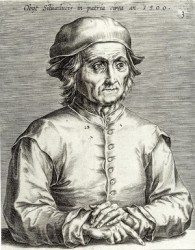
Dollmayr 1898
“Hieronymus Bosch und die Darstellung der vier Letzten Dinge in der niederländischen Malerei des XV. Und XVI. Jahrhunderts” (Hermann Dollmayr) 1898
[in: Jahrbuch der kunsthistorischen Sammlungen des allerhöchsten Kaiserhauses, Band 19 (1898), pp. 284-343]
[Also mentioned in Gibson 1983: 161 (H15)]
We know very little about the life and work of Bosch. Written sources and inventories of later date are not always reliable: the name ‘Bosch’ soon became a general label for everything that was grotesque or fantastic. An example is the written source dating from 1589 mentioning that a Bosch triptych representing Christ’s Entry into Jerusalem was situated in a church in Bonn. The painting, now lost, is said to have been brought to Bonn by a Dutchman who had to emigrate because of his religion. According to Dollmayr the Prado Cutting of the Stone panel is not an original Bosch. The list of authentic Bosch works is not a long one and several paintings have to be removed from this list. On the other hand, Dollmayr can add two works, thought to have been lost, to the oeuvre of the master: the Triptych with a Crucified Female Martyr (Venice) and the Hermits triptych (Venice).
Authentic Bosch works are definitely the beautiful Adoration of the Magi triptych (Prado), the Escorial Christ carrying the Cross, the Escorial Crowning with Thorns and the Lisbon St Anthony triptych. Not original is the Valencia Crowning with Thorns triptych, in which we see a knife with a monogram that can also be found in the Vienna Last Judgment triptych. According to Dollmayr this monogram does not refer to Jan Mandijn, but to a Monogrammist M, a Harlem artist that can perhaps be identified with Jan Mostaert and that could be the discipulo mentioned by Felipe de Guevara. The Seven Deadly Sins panel (Prado), the Haywain triptych (Escorial), the Garden of Earthly Delights triptych (Prado), the Last Judgment triptych (Vienna) and the Cutting of the Stone panel (Prado) are attributed to this Monogrammist M by Dollmayr. It should be noted that, according to his own saying, Dollmayr only knew the Bosch paintings in Spain from photographs [p. 292].
The rest of Dollmayr’s article is an (often rather tedious) survey of the eschatological tradition of Antiquity and the Middle Ages, focusing mainly on descriptions of the underworld and hell. It is no wonder Bosch and others were influenced by this tradition: circa 1500 the fear of devil and witch was gaining momentum. Thanks to the invention of book printing vernacular versions of texts such as St Patrick’s Purgatory, The Vision of Tondal, The Travels of Sir John Mandeville, the Legenda aurea and Le grand Kalendrier et compost des Bergers were widely available. Probably Bosch was influenced by them. And it stands to reason that in times when hell and devil caught so much attention, saints such as St Anthony, St Christopher and St Job, who struggled against the devil, also played an important role.
[explicit 15th September 2015]